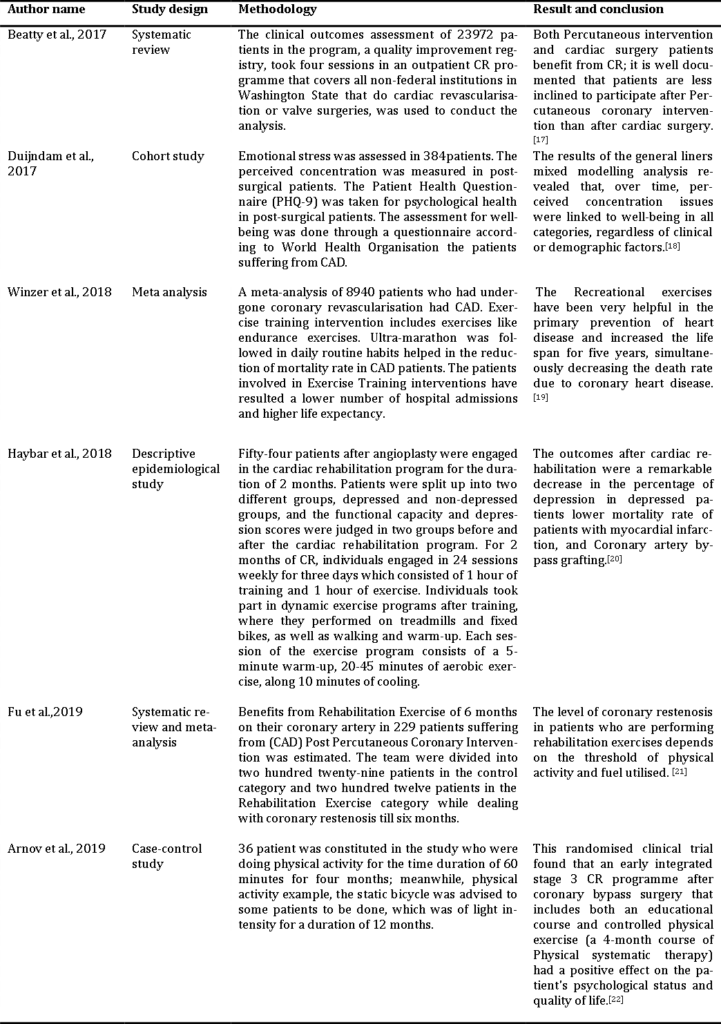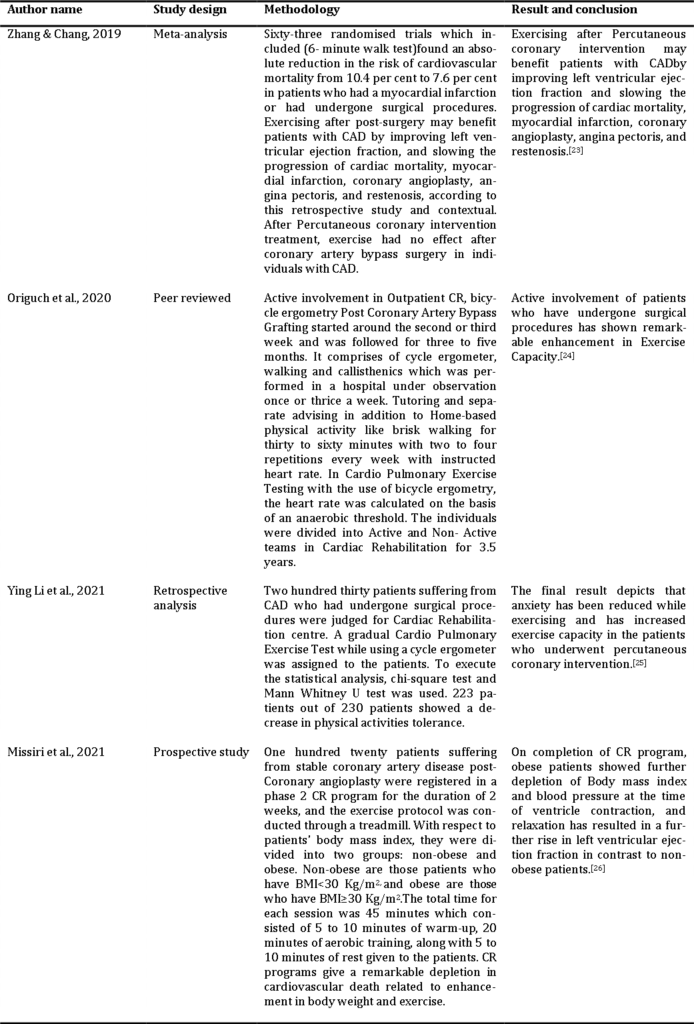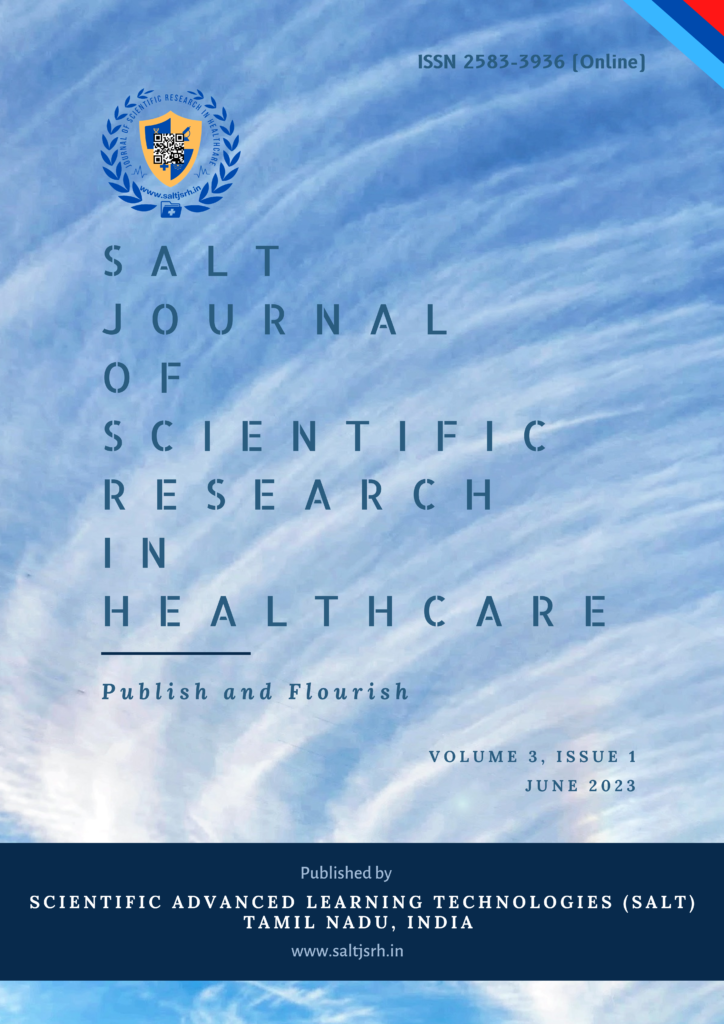CARDIAC REHABILITATION FOR CORONARY ARTERY DISEASE PATIENTS – A LITERATURE REVIEW
Mubashshirah Firdaus Ansari, Nabam Mania, Shivpriya Sharma
Department of Physiotherapy, Sharda University, Greater Noida 201306, India.
Review Article
SALT Journal of Scientific Research in Healthcare, Volume 3, Issue 1, Page 01-10, Published on 08th Feb 2023, https://doi.org/10.56735/saltjsrh.ms2303010110
ABSTRACT
Background and purpose: This literature review objective is to appraise the outcome of Cardiac Rehabilitation for (CAD) patients. Methods: This literature review constitutes the articles which were published in 2017-2022. The evidence search was performed on Google Scholar, PubMed database and Web of science. Results: According to 34 studies incorporated in our literature review shows that cardiac rehabilitation has led to enhancing the well-being of patients suffering from (CAD). We performed a literature review of different articles, including seven studies that were randomised control trials and seven studies that were systematic reviews, and three studies that were meta-analyses providing evidence on the benefits of cardiac rehabilitation and its recent advances in (CAD) patients. Discussion: This literature review, according to selective studies, demonstrates that routine exercise habits act as a precautionary regimen in patients suffering from (CAD). It has led to enhancement in cardiovascular strength and decreasing fatness in a healthy population. Exercise Based (CR) has also shown remarkable outcomes in enhancing the well-being of patients suffering from (CAD).
Keywords: Coronary artery disease, cardiac rehabilitation, home-based cardiac telerehabilitation, exercise-based cardiac rehabilitation.
INTRODUCTION
Coronary Artery Disease (CAD) is an inflammatory disease which occurs due to the formation of atherosclerotic plaque, and the deposition of lipids leads to blockage of the coronary artery, which causes ischemia and decreases the oxygen to the myocardium. An abnormal sequence such as angina, myocardial infarction, arrhythmias, heart failure and at last sudden cardiac arrest is common in CAD.[1] According to the global burden of diseases, widespread coronary artery disease all over the world has 154 million overall diseases related to cardiovascular health.[2] One survey was held constituting the population of 24-64 years in India which shows that 9.7% were people belonging to urban areas and 2.7% were people belonging to rural areas having coronary artery disease.[3] The complication of pharmacological and surgical treatment is higher in these patients; thus, alternative treatment, such as cardiac rehabilitation, can introduce in the treatment protocol.
According to the American Association of Cardiovascular and Pulmonary Rehabilitation (AACVPR), “cardiac rehabilitation (CR) is defined as a comprehensive and coordinated long-term plan, including medical evaluation, exercise prescriptions, interventions for cardiac risk factors, health education, counselling, behavioural interventions, and so on’.[4]AACVPR divides cardiac rehabilitation into 4 phases: Phase 1- Inpatient programme – It takes a time period from 1-14 days. It focuses on advice-giving to the patients by lowering the predisposing factors and drug tolerance and by creating awareness through the engagement of family and patient to restart the activity of daily living.[5] Phase 2 – Sub-Acute-It starts from the eighth day to 6 weeks prior to the outpatient phase. The exercise and making the patient independent is educated to the patient, which comprises of checking the vitals, regulation of clinical manifestations and VO2 max with the help of a workmate. Phase 3- Outpatient based programme or hospital-based programme – It takes a time period from 6 weeks to 12 weeks, and the patient can visit two times a week while it also fulfils the need of larger patients by providing the facilities through domiciliary care, advanced technology like mobiles, digital services and electronic services. Phase 4 Maintenance phase or Community-based programme: In the maintenance phase, the workout performed by the patient can be one time in a week. The patients are made capable of self-inspection while making as a daily routine in their life. It plays a very crucial role in enhancing cardiorespiratory fitness, haemodynamic and muscle physiology. So, the objective of the literature review is to appraise the outcome of CR for CAD patients.[6]
METHODS
Search Strategy
In this literature review, we performed a literature review of different articles, including seven studies that were randomised control trials and seven studies that were systematic reviews and three studies that were meta-analysis providing evidence on the benefits of cardiac rehabilitation and its recent advances in CAD patients. The articles were looked out from Google Scholar and PubMed. Moreover, Scopus indexing was also checked.


 Table 2: Recent articles showing the effect of Postoperative cardiac rehabilitation in coronary artery disease
Table 2: Recent articles showing the effect of Postoperative cardiac rehabilitation in coronary artery disease Table 2: Recent articles showing the effect of Postoperative cardiac rehabilitation in coronary artery disease
Table 2: Recent articles showing the effect of Postoperative cardiac rehabilitation in coronary artery disease Table 3: Recent advances in medical health related to coronary artery disease
Table 3: Recent advances in medical health related to coronary artery diseaseNanotechnology, Biodegradable Stents, Home Based Tele rehabilitation, Tissue Engineering and Behavioural Medicine Intervention in Physiotherapy have shown remarkable effects on CAD patients.
DISCUSSION
Recent studies, according to “American Heart Association” denotes that Exercise Based Cardiac Rehabilitation which comprises Aerobic and Resistance Based Exercise Training, decreases the rise in baseline arterial blood pressure and action of sympathetic nerves to sudden exertion in patients suffering from CAD. Exercise Based CR has shown remarkable outcomes on autonomic function in addition to enhanced baroreflex control on maintaining sympathetic neural control in patients suffering from CAD.[10] The existing reviews, according to “The Journal of Cardiopulmonary Rehabilitation and Prevention”, depicts that remarkable enhancement in Cardiopulmonary Exercise Testing variables in relation to cardiovascular, endothelial, metabolic and autonomic systems was seen in patients suffering from CAD and those who were enrolled for Exercise-Based CR. The favourable outcomes have resulted in enhanced activity of the heart and cardiorespiratory fitness in patients suffering from CAD.[8] The multiple studies, according to “American Heart Association”, demonstrates that routine exercise habits act as a precautionary regimen in patients suffering from CAD. It has led to enhancement in Cardiovascular strength and decreasing fatness in a healthy population. Technology-Based telerehabilitation has resulted in beneficial outcomes in aerobic competency and longevity in patients suffering from CAD.[19] The narrative review, according to “Disability and Rehabilitation”, reveals that Rehabilitation Exercise performed daily has resulted in a remarkable decrease in the narrowing of coronary artery and late luminal loss post (PCI) in patients suffering from (CAD). Rehabilitation exercise started earlier after the (PCI) led to enhanced reserve volume, the functioning of cardiac health and perfusion in the coronary artery along with rapid return in power and decreased prevalence of CAD.[21] According to archives of medical research goal of this research is to judge the cardiac rehabilitation program effectiveness for CAD patients following CABG comprised of controlled medical centre-based physical therapy for four months. The acquired outcomes exhibit the enhancement of the patient’s physical activity in the CE test, along with cardiac productivity.[22] According to the journal of the “American Heart Association, “this study was done on patients with recent ischemic heart disease who were registered in Home-based cardiac rehabilitation and facility-based cardiac rehabilitation. The results were changed in the 6-minute walk distance along with the measure of the quality of life as well enhanced regularly between the HBCR patient.[12] According to “Journal Sports and Medicine”, this study was done on a meta-analysis of 10 RCTs consisting of 1274 patients. The results exhibit that the exercise and (PCI) together work in decreasing the possibility of cardiac death, MI, coronary angioplasty, angina pectoris and restenosis comparative to (PCI) only, along with there was a remarkable enhancement in left ventricular ejection fraction among individuals with exercise compared to those individuals without exercise. The level of hypersensitive C-reactive protein and inflammatory cytokines can decrease in patients suffering from coronary heart disease following PCI by exercise rehabilitation.[23] In the following study, according to “British Medical Journal Open Sport & Exercise Medicine” in mostly female patients suffering from CAD referred for a 24-week outpatient CR program, effects of AIT versus standard care MICE the main conclusion was that this prospective study design was unfeasible in this female CAD patient population, and difficulties encountered.[11] Around the world, according to the “World journal of clinical cases, “CR is underutilised. Inconsistent delivery, inadequate reimbursement, and other CR involvement hurdles in individuals are all issues, according to recent studies.[15] Our findings imply, according to “The International Journal of Behavioral Medicine”, that getting older is linked to improved general well-being, as well as mental health and a suitable atmosphere. Moreover, no effect on the association of cognition and well-being, as poorer perceived cognition was still related to poorer (HRQL).[18]
STUDY STRENGTHS AND LIMITATIONS
The literature review comprises the articles which were published from 2017 to 2022. The strength of the literature review is that it comprises the highest-graded articles like Randomised Control Trials and Systematic Reviews regarding the rehabilitation of patients suffering from (CAD). Moreover, the limitations of this article were that it had no effect on the link between perceived cognition and health-related quality of life. Further studies are still examining that Home Based Cardiac Telerehabilitation as a holistic approach in secondary precaution for CAD.
CONCLUSION
This literature review concluded that the effectiveness of multifaceted rehabilitation services has enhanced the well-being and accentuated follow-up protocol, ultimately leading to a decrease in the death rate of people suffering from CAD. Exercise Training based CR is significant in decreasing the susceptibility to CAD and in providing a longer life expectancy. Cardiopulmonary Exercise Testing (CPET) is used as a valuable and accepted tool in clinical assessment in providing information about medicinal adequacy in those patients suffering from CAD. It is a comprehensive test which has shown a significant increase in cardiopulmonary capacity in post-surgical patients. Outpatient CR has contributed to enhancing physical activity tolerance, decrease in high-risk sleep apnea in patients and greater viability is seen in patients. Further studies examine that Home Based Cardiac Telerehabilitation is a holistic approach in secondary precaution for CAD. Finally, CAD therapeutics’ future with CR appears to be very differently hopeful with the constant endeavour.
REFERENCES
- Erdmann J, Kessler T, Munoz Venegas L, Schunkert H. A decade of genome-wide association studies for coronary artery disease: the challenges ahead. Cardiovasc Res. 2018 Jul 15;114(9):1241-1257. https://doi.org/10.1093/cvr/cvy084. PMID: 29617720.
- Bauersachs R, Zeymer U, Brière JB, Marre C, Bowrin K, Huelsebeck M. Burden of Coronary Artery Disease and Peripheral Artery Disease: A Literature Review. Cardiovasc Ther. 2019 Nov 26;2019:8295054. https://doi.org/10.1155/2019/8295054. PMID: 32099582; PMCID: PMC7024142.
- Malakar AK, Choudhury D, Halder B, Paul P, Uddin A, Chakraborty S. A review on coronary artery disease, its risk factors, and therapeutics. J Cell Physiol. 2019 Aug;234(10):16812-16823. https://doi.org/ 10.1002/jcp.28350. Epub 2019 Feb 20. PMID: 30790284.
- Feng D, Ke J, Huang S, Lang X. A scoping review of exercise-based cardiac rehabilitation for patients with aortic dissection. Rev Cardiovasc Med. 2021 Sep 24;22(3):613-624. https://doi.org/ 10.31083/j.rcm2203072. PMID: 34565064.
- Giuliano C, Parmenter BJ, Baker MK, Mitchell BL, Williams AD, Lyndon K, Mair T, Maiorana A, Smart NA, Levinger I. Cardiac Rehabilitation for Patients With Coronary Artery Disease: A Practical Guide to Enhance Patient Outcomes Through Continuity of Care. Clin Med Insights Cardiol. 2017 Jun 12;11:1179546817710028. https://doi.org/10.1177/1179546817710028. PMID: 28638244; PMCID: PMC5470863.
- Ghanbari-Firoozabadi M, Vafaii Nasab M, Boostani F, Mirzaei M, Amrollahi F, Entezari J, Askari M. Establishment of cardiac rehabilitation program in Yazd-Iran: An experience of a developing country. Int J Cardiol Heart Vasc. 2019 Jul 23;24:100406. https://doi.org/10.1016/j.ijcha.2019.100406. Erratum in: Int J Cardiol Heart Vasc. 2020 Dec 19;32:100698. PMID: 31372492; PMCID: PMC6658926.
- Korzeniowska-Kubacka I, Bilińska M, Piotrowska D, Stepnowska M, Piotrowicz R. The impact of exercise-only-based rehabilitation on depression and anxiety in patients after myocardial infarction. European Journal of Cardiovascular Nursing. 2017 Jun 1;16(5):390-396. https://doi.org/ 10.1177/1474515116682123.
- Popovic D, Kumar N, Chaudhry S, Bagai A, Arena R, Kumar N. Improvements in Key Cardiopulmonary Exercise Testing Variables Following Cardiac Rehabilitation in Patients With Coronary Artery Disease. J Cardiopulm Rehabil Prev. 2018 Sep;38(5):E5-E8. https://doi.org/ 10.1097/HCR.0000000000000324. PMID: 29757824.
- Xia TL, Huang FY, Peng Y, Huang BT, Pu XB, Yang Y, Chai H, Chen M. Efficacy of Different Types of Exercise-Based Cardiac Rehabilitation on Coronary Heart Disease: a Network Meta-analysis. J Gen Intern Med. 2018 Dec;33(12):2201-2209. https://doi.org/ 10.1007/s11606-018-4636-y. Epub 2018 Sep 13. PMID: 30215179; PMCID: PMC6258639.
- Badrov MB, Wood KN, Lalande S, Sawicki CP, Borrell LJ, Barron CC, Vording JL, Fleischhauer A, Suskin N, McGowan CL, Shoemaker JK. Effects of 6 Months of Exercise-Based Cardiac Rehabilitation on Autonomic Function and Neuro-Cardiovascular Stress Reactivity in Coronary Artery Disease Patients. J Am Heart Assoc. 2019 Sep 3;8(17):e012257. https://doi.org/ 10.1161/JAHA.119.012257. Epub 2019 Aug 23. PMID: 31438760; PMCID: PMC6755845.
- Lee LS, Tsai MC, Brooks D, Oh PI. Randomised controlled trial in women with coronary artery disease investigating the effects of aerobic interval training versus moderate intensity continuous exercise in cardiac rehabilitation: CAT versus MICE study. BMJ Open Sport Exerc Med. 2019 Oct 22;5(1):e000589. https://doi.org/ 10.1136/bmjsem-2019-000589. PMID: 31749981; PMCID: PMC6830457.
- Schopfer DW, Whooley MA, Allsup K, Pabst M, Shen H, Tarasovsky G, Duvernoy CS, Forman DE. Effects of Home-Based Cardiac Rehabilitation on Time to Enrollment and Functional Status in Patients With Ischemic Heart Disease. J Am Heart Assoc. 2020 Oct 20;9(19):e016456. https://doi.org/ 10.1161/JAHA.120.016456. Epub 2020 Sep 21. PMID: 32954885; PMCID: PMC7792373.
- Bellmann B, Lin T, Greissinger K, Rottner L, Rillig A, Zimmerling S. The Beneficial Effects of Cardiac Rehabilitation. Cardiol Ther. 2020 Jun;9(1):35-44. https://doi.org/ 10.1007/s40119-020-00164-9. Epub 2020 Jan 29. PMID: 31997145; PMCID: PMC7237601.
- Mendelson M, Inami T, Lyons O, Alshaer H, Marzolini S, Oh P, Bradley TD. Long-term effects of cardiac rehabilitation on sleep apnea severity in patients with coronary artery disease. J Clin Sleep Med. 2020 Jan 15;16(1):65-71. https://doi.org/ 10.5664/jcsm.8124. Epub 2019 Dec 3. PMID: 31957654; PMCID: PMC7053008.
- Winnige P, Vysoky R, Dosbaba F, Batalik L. Cardiac rehabilitation and its essential role in the secondary prevention of cardiovascular diseases. World J Clin Cases. 2021 Mar 16;9(8):1761-1784. https://doi.org/10.12998/wjcc.v9.i8.1761. PMID: 33748226; PMCID: PMC7953385.
- Dibben G, Faulkner J, Oldridge N, Rees K, Thompson DR, Zwisler AD, Taylor RS. Exercise-based cardiac rehabilitation for coronary heart disease. Cochrane Database Syst Rev. 2021 Nov 6;11(11):CD001800. https://doi.org/ 10.1002/14651858.CD001800.pub4. PMID: 34741536; PMCID: PMC8571912.
- Beatty AL, Bradley SM, Maynard C, McCabe JM. Referral to Cardiac Rehabilitation After Percutaneous Coronary Intervention, Coronary Artery Bypass Surgery, and Valve Surgery: Data From the Clinical Outcomes Assessment Program. Circ Cardiovasc Qual Outcomes. 2017 Jun;10(6):e003364. https://doi.org/10.1161/CIRCOUTCOMES.116.003364. PMID: 28619725.
- Duijndam S, Denollet J, Nyklíček I, Kupper N. Perceived Cognition after Percutaneous Coronary Intervention: Association with Quality of Life, Mood and Fatigue in the THORESCI Study. Int J Behav Med. 2017 Aug;24(4):552-562. https://doi.org/ 10.1007/s12529-016-9624-1. PMID: 28032322; PMCID: PMC5509816.
- Winzer EB, Woitek F, Linke A. Physical Activity in the Prevention and Treatment of Coronary Artery Disease. J Am Heart Assoc. 2018 Feb 8;7(4):e007725. https://doi.org/10.1161/JAHA.117.007725. PMID: 29437600; PMCID: PMC5850195.
- Haybar H, Shirani T, Pakseresht S. Evaluation of cardiac rehabilitation on functional capacity in depressed and nondepressed patients after angioplasty. J Family Med Prim Care. 2018 Nov-Dec;7(6):1304-1308. https://doi.org/ 10.4103/jfmpc.jfmpc_306_18. PMID: 30613516; PMCID: PMC6293924.
- Fu C, Wang H, Wei Q, He C, Zhang C. Effects of rehabilitation exercise on coronary artery after percutaneous coronary intervention in patients with coronary heart disease: a systematic review and meta-analysis. Disabil Rehabil. 2019 Dec;41(24):2881-2887. https://doi.org/ 10.1080/09638288.2018.1481148. Epub 2018 Jul 10. PMID: 29991296.
- Aronov D, Bubnova M, Iosseliani D, Orekhov A. Clinical Efficacy of а Medical Centre- and Home-based Cardiac Rehabilitation Program for Patients with Coronary Heart Disease After Coronary Bypass Graft Surgery. Arch Med Res. 2019 Apr;50(3):122-132. https://doi.org/ 10.1016/j.arcmed.2019.07.007. Epub 2019 Aug 7. PMID: 31495389.
- Zhang H, Chang R. Effects of Exercise after Percutaneous Coronary Intervention on Cardiac Function and Cardiovascular Adverse Events in Patients with Coronary Heart Disease: Systematic Review and Meta-Analysis. J Sports Sci Med. 2019 Jun 1;18(2):213-222. PMID: 31191090; PMCID: PMC6543998.
- Origuchi H, Itoh H, Momomura SI, Nohara R, Daida H, Masuda T, Kohzuki M, Makita S, Ueshima K, Nagayama M, Omiya K, Adachi H, Goto Y. Active Participation in Outpatient Cardiac Rehabilitation Is Associated With Better Prognosis After Coronary Artery Bypass Graft Surgery- J-REHAB CABG Study. Circ J. 2020 Feb 25;84(3):427-435. https://doi.org/ 10.1253/circj.CJ-19-0650. Epub 2020 Feb 8. PMID: 32037378.
- Li Y, Feng X, Chen B, Liu H. Retrospective analysis of exercise capacity in patients with coronary artery disease after percutaneous coronary intervention or coronary artery bypass graft. Int J Nurs Sci. 2021 Jun 3;8(3):257-263. https://doi.org/ 10.1016/j.ijnss.2021.05.008. PMID: 34307773; PMCID: PMC8283701.
- El Missiri A, Abdel Halim WA, Almaweri AS, Mohamed TR. Effect of a phase 2 cardiac rehabilitation program on obese and non-obese patients with stable coronary artery disease. Egypt Heart J. 2021 Jan 7;73(1):4. https://doi.org/ 10.1186/s43044-020-00119-4. PMID: 33411160; PMCID: PMC7790927.
- Kandaswamy E, Zuo L. Recent Advances in Treatment of Coronary Artery Disease: Role of Science and Technology. Int J Mol Sci. 2018 Jan 31;19(2):424. https://doi.org/ 10.3390/ijms19020424. PMID: 29385089; PMCID: PMC5855646.
- Li T, Liang W, Xiao X, Qian Y. Nanotechnology, an alternative with promising prospects and advantages for the treatment of cardiovascular diseases. Int J Nanomedicine. 2018 Nov 9;13:7349-7362. https://doi.org/ 10.2147/IJN.S179678. PMID: 30519019; PMCID: PMC6233477.
- Md ST, Ansari AQ, Urooj S, Aldobali M. A review based on biodegradable and bioabsorbable stents for coronary artery disease. Procedia Computer Science. 2019 Jan 1; 152: 354-359. https://doi.org/10.1016/j.procs.2019.05.006.
- Borg S, Öberg B, Nilsson L, Söderlund A, Bäck M. The Added Value of a Behavioral Medicine Intervention in Physiotherapy on Adherence and Physical Fitness in Exercise-Based Cardiac Rehabilitation (ECRA): A Randomised, Controlled Trial. Patient Prefer Adherence. 2020 Dec 24;14:2517-2529. https://doi.org/ 10.2147/PPA.S285905. PMID: 33380790; PMCID: PMC7769595.
- Ramachandran HJ, Jiang Y, Teo JYC, Yeo TJ, Wang W. Technology Acceptance of Home-Based Cardiac Telerehabilitation Programs in Patients With Coronary Heart Disease: Systematic Scoping Review. J Med Internet Res. 2022 Jan 7;24(1):e34657. https://doi.org/ 10.2196/34657. PMID: 34994711; PMCID: PMC8783276.
ARTICLE TYPE: Review Article; ORCID ID: Open Researcher and Contributor Identifier (ORCID) ID of corresponding author: https://orcid.org/0000-0003-4668-3102 ; ETHICAL: Institutional ethical committee and prior patient consent obtained; ACKNOWLEDGEMENT: None; FINANCIAL DISCLOSURE: The authors declare that there was no financial aid received.; CONFLICT OF INTEREST: No conflict of interest associated with this research work.; AUTHORS CONTRIBUTION: M.F.A., N.M., and R.S., reviewed and wrote the article for publication.; AUTHORS AFFILIATIONS: Ms. Mubashshirah Firdaus Ansari, BPT Intern Student, Department of Physiotherapy, SAHS, Sharda University, Greater Noida 201306; Ms. Nabam Mania, BPT Intern Student, Department of Physiotherapy, SAHS, Sharda University, Greater Noida 201306; Ms. Shivpriya Sharma, Assistant Professor, Department of Physiotherapy, Sharda University, Greater Noida 201306, India.; CORRESPONDING AUTHOR EMAIL: shivpriya.sharma@ sharda.ac.in; ARTICLE CITATION: Ansari MF, Mania N & Sharma S. Cardiac rehabilitation for coronary artery disease patients- a literature review. SALT J Sci Res Healthc. 2023 February 08; 3(1): 01-10.
PUBLISHER’S NOTE: All claims expressed in this article are solely those of the authors and do not necessarily represent those of their affiliated organizations, or those of the publisher, the editors and the reviewers. Any product that may be evaluated in this article, or claim that may be made by its manufacturer, is not guaranteed or endorsed by the publisher.



© Mubashshirah Firdaus Ansari, Nabam Mania, Shivpriya Sharma
Originally published in the SALT Journal of Scientific Research in Healthcare (https://saltjsrh.in/), 08.02.2023.
This is an open-access article distributed under the terms of the Creative Commons License (https://creativecommons.org/licenses/by-nc-nd/4.0/), which permits unrestricted use, distribution, and reproduction in any medium, provided the original work, first published in the SALT Journal of Scientific Research in Healthcare (https://saltjsrh.in/), is properly cited. The complete bibliographic information, a link to the original publication on https://saltjsrh.in/, as well as this copyright and license information must be included.